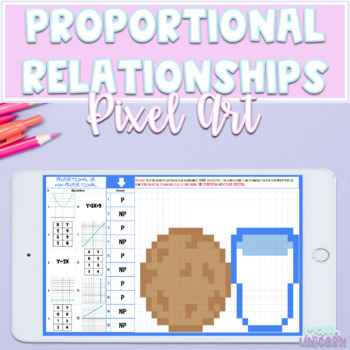Proportional Relationships from Equations, Graphs & Tables Pixel Art
- Google Drive™ folder
- Internet Activities

What educators are saying
Also included in
- Teach your students integer operations, slope and y-intercept, converting decimals into percentages, inequalities, division with these engaging middle school pixel art activities. This bundle includes over 25 digital pixel art activities in Google Sheets that are great for distance learning, math cPrice $75.00Original Price $97.00Save $22.00
- Teach your student about Proportional Relationships from equations, real-life scenarios, graphs and tables with this fun and engaging activities. These resources are great for your classrooms math centers, internet activities, distance learning warm up, independent work, quiz, homework or instructioPrice $11.00Original Price $12.50Save $1.50
Description
Teach your students Proportional Relationships from equations, graphs and tables with this fun and engaging pixel art activity. Your students will solve 10 questions by looking at the equation, graph or table in each cell and determine if it is proportional or non-proportional then enter their responses in the provided space. As they answer correctly pieces of a mystery picture will begin to appear. By the end, they will have created a cookie and milk! This activity is great for your classrooms math centers, distance learning, internet activities, warm up, independent work, quiz, homework or instructional technology day.
This resource is create in Google. You will receive a folder with the student copy, answer key, terms of use and credits.
You may also like this resource:
- Identifying Functions from Graphs Maze | Digital & Printable | Distance Learning
- Exponents: Maze Digital & Printable Activity | Distance Learning | Google App
- Simplifying Improper Fractions Maze | Printable & Digital
Get FREE TPT credit to use on future purchases!
- Head on over to your "My Purchases" page. Look at each one of the fantastic products you've purchased from incredible TPT educators and click on "Provide Feedback"!
- Write a short comment to the seller about their product (be honest but fair) and use the "star ratings" to grade the product! After you submit, you will then receive TPT credits in your account!
- Take it one step further! Look for the green star next to my store log and click it to become a follower! You will now receive email updates about my store.
Licensing Terms:
By purchasing this product, you own a license for ONE TEACHER ONLY for personal use in their own classroom. Licenses are non-transferable and therefore can NOT be passed from one teacher to another. No part of this resource is to be shared with colleagues or used by an entire team, grade level, school or district without purchasing the correct number of licenses.




